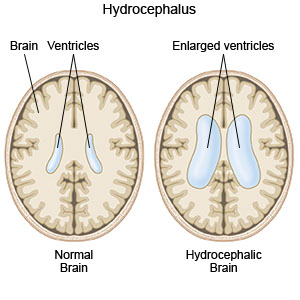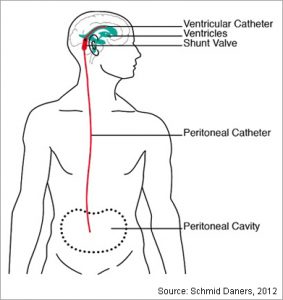Part
01
of one
Part
01
Hydrocephalus
Key Takeaways
- It is common for the cause of hydrocephalus to be unknown.
- There are two main treatments for hydrocephalus, surgery to implant a shunt system and an endoscopic third ventriculostomy (ETV). Research does not indicate that there are currently any non-surgical treatments for hydrocephalus.
- One indicator that may give some insight into the type of hydrocephalus is the speed that symptoms appear. This is because hydrocephalus usually develops quickly, but in the case of NPH, it happens more gradually.
- There are three research studies in the area of hydrocephalus that are currently recruiting in the San Francisco area.
- UCSF Health-UCSF Medical Center in San Francisco is ranked one of the top hospitals in neurosurgery in the US. According to US News Health, there are 12 doctors with 5 star ratings who are affiliated with that hospital.
Introduction
Provided below is an overview of acquired (versus congenital) hydrocephalus including the types, causes, treatments, and diagnostic tools. Additionally, there are links to five studies that have been done on hydrocephalus in the last couple of years. Finally, some data is provided on the best US hospitals for neurosurgery, as well as links to some highly rated doctors in the San Francisco area.
Types of Hydrocephalus
- The following definitions have been quoted directly from the NIH.
- (1) "Communicating hydrocephalus occurs when the flow of CSF is blocked after it exits the ventricles. This form is called communicating because the CSF can still flow between the ventricles, the passages between which remain open. Reduced flow and absorption of CSF into specialized blood vessels called arachnoid villi can also result in a buildup of CSF in the ventricles and communicating hydrocephalus." This type can be further broken into:
- (1a) "Hydrocephalus ex-vacuo results from brain damage caused by stroke or injury. In these cases, brain tissues around the ventricles shrink, and the ventricles are bigger than normal because of this. Strictly speaking, this is not a true hydrocephalus, but rather, a “hydrocephalus look-alike” condition."
- (1b) "Normal Pressure Hydrocephalus (NPH) can be the result of bleeding in the brain’s CSF (subarachnoid or intraventricular hemorrhage), head trauma, infection, tumor, or a complication of surgery. However, many people develop NPH when none of these factors are present. The increase in cerebrospinal fluid in NPH occurs slowly enough that the tissues around the ventricles compensate and the fluid pressure inside the head does not increase. NPH causes problems with walking, bladder control, and difficulties thinking and reasoning. Sometimes NPH can be mistaken for Alzheimer’s disease."
- (2) "Non-communicating hydrocephalus happens when the flow of CSF is blocked along one or more of the narrow passages connecting the ventricles."
- The incidence of NPH has been estimated at 8.9% for those over 80.
Causes of Hydrocephalus
- "Hydrocephalus is the buildup of fluid in the cavities (ventricles) deep within the brain. The excess fluid increases the size of the ventricles and puts pressure on the brain." Under normal functioning, the cerebrospinal fluid produced by tissues in the brain flows through ventricles in the brain and is then absorbed.
- The most common reason for the buildup of fluid is that there is some type of partial blockage that keeps the fluid from flowing, which results in fluid being produced more rapidly than it can be absorbed.
- Excess fluid in the brain can also result from poor absorption, often related to some type of brain inflammation, or overproduction of fluid, where fluid is produced faster than it can be absorbed.
- While the cause of hydrocephalus is often unknown, there are a few known problems that can contribute to the development of the disease. These are lesions or tumors in the brain or spinal column, infections of the central nervous system, brain bleeding from a stroke or head injury, and traumatic brain injuries.
- When testing determines that the hydrocephalus is not caused by one of the known contributing factors, the cause will often remain unknown.
- NPH only occurs in people who are 50 or older. This type is distinguished from the others in the way it develops. Often hydrocephalus develops quickly, but in the case of NPH, it happens more gradually. Therefore, the speed of symptom onset can be a distinguishing factor in determining the type of hydrocephalus, however, the cause of NPH is most often undetermined. Common symptoms of NPH, dementia-like problems and walking difficulties, can look like Alzheimer's or Parkinson's disease.
- Information on the UK website of the National Health Service (NHS) indicates that NPH in older adults may be linked to other conditions that affect blood flow, such as diabetes, heart disease, and high cholesterol. However, it should be emphasized that this appears to be a theory, rather than a definitive statement. Although the majority of the study was behind a paywall, here is a link to the study that examines the possible connection between hydrocephalus and high cholesterol.
Testing and Diagnosis
- In addition to a complete physical exam, a patient will receive a complete neurological exam, and also may be subject to a variety of diagnostic tests.
- According to John Hopkins Medicine, a neurological exam includes evaluations of mental status; motor function and balance; sense of touch; reflexes; brain nerves; and coordination.
- There are a variety of diagnostic tests that are used when diagnosing hydrocephalus. They include CT or CAT scan, MRI, isotopic cisternography, lumbar puncture (spinal tap), and intracranial pressure monitoring.
Treatment Options
- According to multiple reputable sources (NIH, NHS, and the American Association of Neurological Surgeons), acquired hydrocephalus is typically treated through surgery. The most common surgery is to implant a shunt, a flexible tube, which diverts the extra fluid away from the brain to relieve the pressure. The second surgery is called an endoscopic third ventriculostomy (ETV), and involves making "a hole in the floor of your brain to allow the trapped cerebrospinal fluid (CSF) to escape to the brain's surface, where it can be absorbed."
- The complications and risks associated with shunt surgery include blockage, shunt malfunction (over- or under-drainage), infection at the wound site, infection at the site of the shunt, and an infection of the brain fluid (meningitis). Additionally, patients may need more surgeries to adjust or replace shunts. One statistic states that about 50% of shunts will need to be replaced after 6 years.
- ETV surgery had fallen out of favor, but there has been renewed interest due to a technology advancement called neuroendoscopy. The technology allows the neurosurgeon to see the ventricular system while performing surgery.
- According to the Hydrocephalus Association, the most common complications with ETV are "the closure of the pathway that is surgically created with ETV, and infection." The NHS reports that the most common complications of the surgery are fever and bleeding.
- Less common complications of ETV surgery are short term memory loss, endocrine malfunction, and diabetes insipidus. All of these complications usually resolve with time.
- None of the resources we found mentioned any nonsurgical options for treating hydrocephalus. In fact, a study published in 2016 reviewed available studies on nonsurgical treatments and concluded that, "Despite over 5 decades research, no compelling non-surgical therapies have been developed for hydrocephalus." However, there is still research happening in this area
Current Areas of Research
- A review of ClinicalTrials.gov found three research studies on hydrocephalus that are happening within 100 miles of San Francisco, and are currently recruiting. Those can be found here, here, and here. Expanding the search radius to 300 miles did not result in any additional active studies.
- There are numerous studies that have been published within the last two years on acquired hydrocephalus. Acquired refers to any type of the disease that occurs after birth, and was not congenitally present at birth. Below are the titles and links to five studies that were found, although this only scratches the surface of what is available.
- A novel model of acquired hydrocephalus for evaluation of neurosurgical treatments
- Acquired hydrocephalus is associated with neuroinflammation, progenitor loss, and cellular changes in the subventricular zone and periventricular white matter
- Navigating the ventricles: Novel insights into the pathogenesis of hydrocephalus
- Level of IL-6 in cerebrospinal fluid is a preoperative predictor of short - term outcome in acquired hydrocephalus
- A mathematical model for predicting intracranial pressure based on noninvasively acquired PC-MRI parameters in communicating hydrocephalus
California Bay Area Experts
- UCSF Health-UCSF Medical Center in San Francisco and UCLA Medical Center were both in the top 10 for best hospitals for neurosurgery, according to US News & World Report. Newsweek did not have any California hospitals in its top 10 list, but UCSF Medical Center was number 11 on the list and Stanford Hospital was number 15.
- Other top hospitals that are outside of California include New York-Presbyterian Hospital-Columbia and Cornell, John Hopkins, Mayo Clinic, Cleveland Clinic, and Mount Sinai. All these hospitals were in the top 10 on both the US News and Newsweek lists.
- Here is a link to the neurosurgeons practicing at UCSF Health.
- On US News Health there were a total of 18 neurosurgeons in the San Francisco area that had ratings of 5 stars, and were affiliated with a top hospital. Although there was not time to review all of them within the scope of this report, an examination of the first five found that they all mentioned hydrocephalus as a specialty. There were a total of 12 doctors with 5 star ratings that were also affiliated with UCSF.
Research Strategy
For this research on hydrocephalus we leveraged the most reputable sources of information that were available in the public domain, including the Mayo Clinic, NIH, NHS, clinicaltrials.gov, US News and World Report, and Science Direct.
Of note, there were numerous topics that needed to be covered in a short amount of research time. Therefore, this report provides a broad overview rather than an in-depth analysis.


